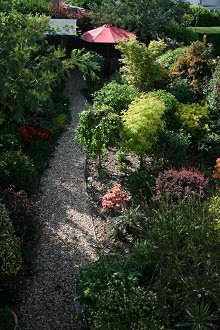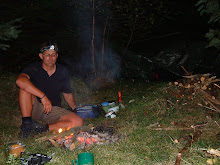The autumn leaf drop appears to be happening rather fast this year, and it's a time of year that often has me feeling quite reflective about my own life and mortality, perhaps a little too much sometimes. As a gardener though, it is a gentle reminder that rather than the plants that my hands touch throughout the year being under my control or ownership, they are instead just allowing me to be part of their lives in a symbiotic kind of way.
Throughout the year, we gardeners trim, prune, feed, water and dead-head our plants, making them perform to what we consider to be their optimum level. They respond by perhaps becoming a little larger, more formative, or colourful. We take out dead growth to help prevent any disease taking hold, and introduce additions to our plant 'family' that sometimes work, and at other times don't. We demand a lot from that which we nurture, but come autumn it's their turn to say 'enough, we need a rest!' In most cases, regardless of whether or not the temperature has dropped to any marked degree, changes within plants start to happen. Less daylight and lower temperatures slow down photosynthesis in the leaves until they eventually fall, the plants take up less water and growth slows to a standstill. Evergreens just cease to move. Sure, as humans, we can and do even control this in some circumstances where mass cultivation is carried out, but left to nature it's very simple and right.......they need to go to sleep for a short while.
Things become either very green and plain, or stick like, and so we try to bring a little colour into this barren land with the addition of things like Callicarpa bodinieri, Skimmia rubella or Cornus and such like, but overall things need to slow down, including us gardeners.
Callicarpa bodinieri
For professional gardeners, the next few months are a very forgiving time, where the toils of the summer such as mowing, hedgecutting and constant tidying are instead exchanged for a slightly easier life of pruning, putting right those planting mistakes we made, or making a border better by transplanting or removing things. It's a time of tidying up the herbaceous border, always a pleasant task, and dividing up any clumps that need it, which always gives us 'spares' to plant elsewhere or give to friends. It's a time to put pen to paper, and plan new schemes and browse nursery catalogues. A time to empty and replant pots and planters with colourful annuals or more interesting perennials ready for next year. Although I hate the rain that comes at times, I do so love the clear, icy cold and sunny days that we also get. I wonder what new innovations and schemes will be presented at Chelsea and Hampton Court next year? I could be mistaken, but garden designers appear to be moving back towards proper gardening, and away from the concrete monolith and decking monstrocities that were once headlining. On this note, I would like to end with a short verse by Alexander Pope that I saw whilst visiting Stourhead Gardens yesterday, and one that I am sure the gardens designer Henry Hoare II would quite obviously agree with.
To build, to plant,whatever you intend,
To rear the column, or the Arch to bend,
To swell the Terras,or to sink the Grot;
In all, let nature nevar be forgot.
Thanks for reflecting with me.
























































Hello Gary:
ReplyDeleteLate autumn with winter around the corner is, indeed, a time for reflection particularly where gardens and gardening are concerned. We well remember from our own gardening days the quiet satisfaction to be had from the physical labour of 'putting the garden to bed' and the respite afforded once the work was done. Increasingly the garden in winter, with the 'bones' so much in evidence, became one of our favourite times.
Dear Jane & Lance,
ReplyDeleteAlthough it's raining hard at the moment, and I am unable (choose not to!) to work, I still love this time of year. Come December, all will be 'at rest' in the gardens.
Thanks Sherlock.
ReplyDelete